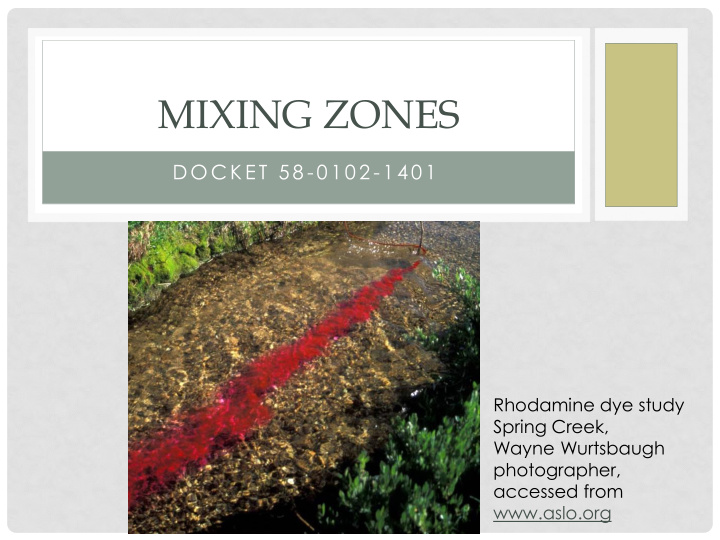



MIXING ZONES DOCK E T 5 8 -0 1 0 2 -1 4 0 1 Rhodamine dye study Spring Creek, Wayne Wurtsbaugh photographer, accessed from www.aslo.org
OUTLINE • Review comments received • Discuss draft rule version 2 • Discuss section 060.01.d • Future topics and path forward 2
COMMENTS RECEIVED
COMMENTERS • Chris Mebane • EPA • IACI • ICL • IMA • NOAA and FWS • Simplot
SUMMARY OF COMMENTS • Many comments directed towards sections other than 01.b, 01.e, 01.f, and 01.h • Will retain those comments for drafting revisions to next version of draft rule • See handout “Summary of Comments Received” May 22, 2014
DRAFT RULE VERSION 2 CHANGES AND ADDITIONS
060.01.b Water quality within an authorized mixing zone is allowed to exceed chronic water quality criteria for those parameters approved by the Department . If approved by the Department, acute water quality criteria for one or more parameters may be exceeded within the zone of initial dilution inside the mixing zone. All water quality criteria must be met at the boundary of any mixing zone under its design conditions.
060.01.e Multiple nested mixing zones may be established for a single point of discharge, each being specific for one(1) or more pollutants contained within the discharged wastewater.
060.01.f Multiple mixing zones can be established for a single activity with multiple points of discharge. When these individual mixing zones overlap or merge, their combined area and volume shall not exceed that which would be allowed if there was a single point of discharge. When these individual mixing zones do not overlap or merge, they may be authorized as individual mixing zones.
060.01.h Mixing zones shall meet the following restrictions; provided, however, that the Department may authorize mixing zones that vary from the restrictions under the circumstances set forth in section 060.01.i below: i. The width of a mixing zone is not to exceed twenty- five percent (25%) of the stream width, and ii. The mixing zone shall not include more than twenty- five percent (25%) of the low flow design discharge conditions as set forth in section 210.03.b of these rules.
060.01.i The Department may authorize a mixing zone that varies from the limits in section 060.01.h if it is established that: i. A smaller mixing zone is needed to avoid an unreasonable interference with, or danger to, existing beneficial uses as described in section 060.01.d and the mixing zone meets the other requirements set forth in section 060; or ii. A larger mixing zone is needed by the discharger and does not cause an unreasonable interference with, or danger to, existing beneficial uses as described in section 060.01.d and the mixing zone meets the other requirements set forth in section 060.
060.01.j The Department recommends the following elements when designing an outfall. i. Encourage rapid mixing to the extent possible. This may be done through careful location and design of the outfall. ii. Avoid shore-hugging plumes in those water bodies where the littoral zone is a major supply of food and cover for migrating fish or where recreational activities are impacted by the plume.
060.01.d UNREASONABLE INTERFERENCE
MIXING ZONES SHOULD • Define zone where numeric criteria can be exceeded • Allow for dilution of discharge when TBELs are not sufficient to protect water quality thereby reducing need for excessive wastewater treatment • Protect the beneficial uses of the water body as a whole • Prevent lethality to passing organisms • Prevent significant health risks 14
060.01.d • Mixing zones shall not cause unreasonable interference with, or danger to, existing beneficial uses. • This language is consistent between current and draft rule. • What is unreasonable interference?
UNREASONABLE INTERFERENCE • Blocks safe passage for fish, • Causes destructive or adverse modification to critical habitat, • Increases temperature in receiving water to the point where thermal shock, immediate lethality, or loss of cold water refugia occurs, • Causes acute toxicity (toxic effects <1 hour) outside the zone of initial dilution, • Causes exceedances of MCLs at drinking water intakes, • Interferes with public swimming areas.
BIOACCUMULATION • The tendency for a chemical to accumulate in tissue in organisms. • Numeric toxics criteria currently utilize bioconcentration factors. • Loading as well as concentration are factors that affect the overall impacts by bioaccumulatives.
TRANSITION TO DRAFT RULE
PATH FORWARD • July 10 th • Draft revision 3 • Sections 060.01.a, .c, and .g & Section 060.02 Nonpoint Source Discharges • Discharges to non-flowing waters • Stormwater • Comment period through July 24 th • Revisions based on this comment period • August 8 th deadline • Draft 4 based on all received comments submitted for publication in September bulletin • Comment period for this through Oct 3 rd
Recommend
More recommend